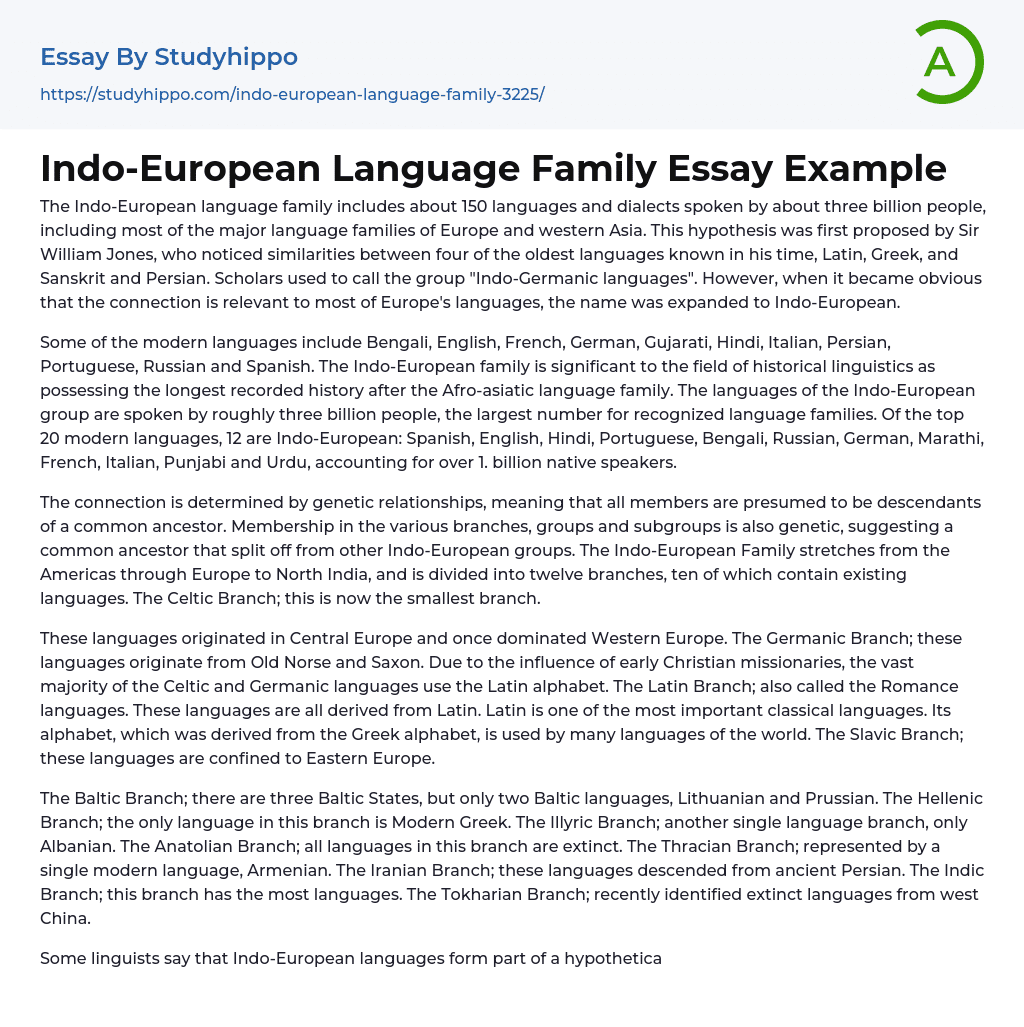The Indo-European language family includes about 150 languages and dialects spoken by about three billion people, including most of the major language families of Europe and western Asia. This hypothesis was first proposed by Sir William Jones, who noticed similarities between four of the oldest languages known in his time, Latin, Greek, and Sanskrit and Persian. Scholars used to call the group "Indo-Germanic languages". However, when it became obvious that the connection is relevant to most of Europe's languages, the name was expanded to Indo-European.
Some of the modern languages include Bengali, English, French, German, Gujarati, Hindi, Italian, Persian, Portuguese, Russian and Spanish. The Indo-European family is significant to the field of historical linguistics as possessing the longest recorded history after the Afro-asiatic language family. The languages of the Indo-European group are spoken by roughly three billion people, the
...largest number for recognized language families. Of the top 20 modern languages, 12 are Indo-European: Spanish, English, Hindi, Portuguese, Bengali, Russian, German, Marathi, French, Italian, Punjabi and Urdu, accounting for over 1. billion native speakers.
The connection is determined by genetic relationships, meaning that all members are presumed to be descendants of a common ancestor. Membership in the various branches, groups and subgroups is also genetic, suggesting a common ancestor that split off from other Indo-European groups. The Indo-European Family stretches from the Americas through Europe to North India, and is divided into twelve branches, ten of which contain existing languages. The Celtic Branch; this is now the smallest branch.
These languages originated in Central Europe and once dominated Western Europe. The Germanic Branch; these languages originate from Old Norse and Saxon. Due to the influence of early Christia
missionaries, the vast majority of the Celtic and Germanic languages use the Latin alphabet. The Latin Branch; also called the Romance languages. These languages are all derived from Latin. Latin is one of the most important classical languages. Its alphabet, which was derived from the Greek alphabet, is used by many languages of the world. The Slavic Branch; these languages are confined to Eastern Europe.
The Baltic Branch; there are three Baltic States, but only two Baltic languages, Lithuanian and Prussian. The Hellenic Branch; the only language in this branch is Modern Greek. The Illyric Branch; another single language branch, only Albanian. The Anatolian Branch; all languages in this branch are extinct. The Thracian Branch; represented by a single modern language, Armenian. The Iranian Branch; these languages descended from ancient Persian. The Indic Branch; this branch has the most languages. The Tokharian Branch; recently identified extinct languages from west China.
Some linguists say that Indo-European languages form part of a hypothetical Nostratic language family, and attempt to relate Indo-European to other language families, such as South Caucasian languages, Uralic languages, Dravidian languages, and Afro-asiatic languages. This theory remains highly controversial, and is not accepted by most linguists in the field. Objections to such groupings are not based on any theoretical claim about the likely historical existence or non-existence of such families; it is entirely reasonable to suppose that they might have existed.
- Ethnic Group essays
- Berlin essays
- Pompeii essays
- Paris essays
- Athens essays
- Belgium essays
- England essays
- Germany essays
- Greece essays
- Ireland essays
- Italy essays
- London essays
- Russia essays
- Spain essays
- United Kingdom essays
- Great britain essays
- Rome essays
- British essays
- Birmingham essays
- Home essays
- Dog essays
- Adoption essays
- Babies essays
- Children essays
- Love essays
- Parenting Teens essays
- Wedding essays
- Wife essays
- Aunt essays
- Daughter essays
- Parents essays
- Sister essays
- Foster Care essays
- Sibling essays
- Father essays
- Grandparent essays
- Mother essays
- Caring essays
- Dysfunctional Family essays
- Bedroom essays
- Room essays
- Relationship essays
- Jealousy essays
- Friends essays
- Online Dating essays
- Divorce essays
- Husband essays
- Marriage essays
- Hometown essays
- Parenting essays




